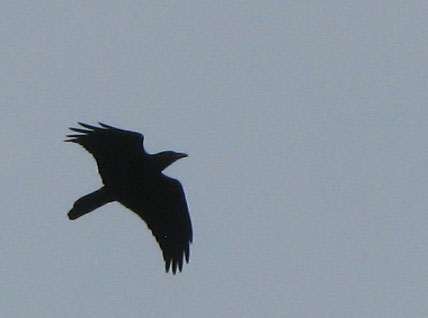Excerpts from Jim Conrad's
Naturalist Newsletter
from the January 6, 2013 Newsletter issued from the valley of the Dry Frio River in northern Uvalde County, southwestern Texas, on the southern border of the Edwards Plateau; elevation ~1750m (~5750 ft); N29.62°, W99.86°; USA
RAVENS
A general rule in my life has been that I'm happiest where there are ravens in the neighborhood. That's because ravens like wild, mostly unpeopled areas, and I do, too. To me nothing sounds as promising as the raspy croaking of ravens echoing off high cliffs, or filtering through widely spaced pines of an isolated, scrubby canyon.
We have ravens here. They hang out in the rocky hills rising on both sides of the Dry Frio River Valley. Regularly they fly over the cabin I'm staying in but they never land. Overhead they keep at a safe distance looking down at things on the floodplain floor, landing only when they have rocky slopes below them. The other day one flew over the house when the camera was ready, so you can see his silhouette below:

We have two raven species in this area, the Common Raven, Corvus corax, and the Chihuahuan Raven, once called the White-necked Raven, Corvus cryptoleucus. They're hard to tell apart unless the Chihuahuan crooks his neck just right so you can see his white collar. They have different voices, but I read that young Common Ravens can sound much like Chihuahuans. The one in the picture was calling with a voice other than the hoarse croak I associate with adult Common Ravens, but I often do hear the Common's classic hoarse croaks off in the hills. The silhouette in the picture, especially with that wedge-shaped tail, certainly looks like the Common Raven, but silhouettes of Chihuahuan Ravens on the Internet look pretty much the same.
A local birder who seems to know his stuff says that in the flatlands here in northern Uvalde County, until a couple of years ago the raven to be expected -- "the default raven" he calls it -- was the Chihuahuan Raven, with Common Ravens staying in sight of cliffs and rocky outcrops. But then the historic drought we're in right now began and this area's Chihuahuans left, turning up now mostly as fall migrants.
So, because I've heard the classic hoarse croaks and know that Common Ravens are nearby, and because of that local birder's observations, I'm saying that what's in the picture probably is a Common Raven, but I'm not entirely sure.
My most vivid memory of watching Common Ravens is from when I wrote my 1996 online book A Birding Trip Through Mexico, still available at http://www.backyardnature.net/mexbirds/.
During that trip I camped at about 4,050 meters (13,287 ft.) on Nevado de Toluca Volcano in central Mexico, where each afternoon Common Ravens flew about the volcano's rim.
"They don't seem to be searching for food," I wrote. "They just spend an hour zooming toward cliff faces, banking at the last moment, and stalling with cupped wings where mighty blasts of upward streaming wind rise beneath them. What could these Common Ravens be doing but playing with the wind?"